Fishing Report: First week of 2022

Tampa Bay Fishing Forecast: Jan. 1, 2022
Captain Dylan Hubbard says redfish are abundant in back bay areas and residential canals as we kick off 2022. He also says anglers should also be able to find plenty of flounder, snook, trout and sheepshead.
MADEIRA BEACH, Fla. - Every Friday morning, Captain Dylan Hubbard of Hubbard's Marina joins Good Day to fill viewers in on his fishing forecast as we head into the weekend.
Here is his fishing report for December 31, 2021.
Weather effects on fishing
We are coming up on a new moon with a big cold front coming down to the area too.
These two things coupled together should bring us some good fishing over the weekend. Sunday right before the front fishing should be hot. However, we will have a strong south wind over the weekend too which will make getting to the fish a bit more difficult. Find those wind-protected shorelines and passes protected from the wind.
LINK: FOX 13 weather forecast
Behind the front, sometime Tuesday or Wednesday, once weather calms and waters start to clear, the fishing should pick back up for a decent mid-week bite too. We will have a bouncing barometer through the week prior to what looks like a possible weekend front.
Aim to fish this weekend while fishing looks great, but take caution, avoiding wind or head out mid-week when weather looks great, and fishing should be good too!
Inshore
Redfish bite has been steady around the area this past week. Around the passes, we are seeing them on the docks, bridges, and structures hanging on the bottom, ambushing passing crustaceans and smaller live bait fish too.
In the back bays, they are on the residential dock lines and active around oyster bars and mangrove shorelines at higher tides. At lower tides, look for them around those potholes, dock lines, or edges of the flats. At night, dock lights, bridge lights and other light sources help concentrate bait. The redfish are often on the bottom picking off what bait they can.
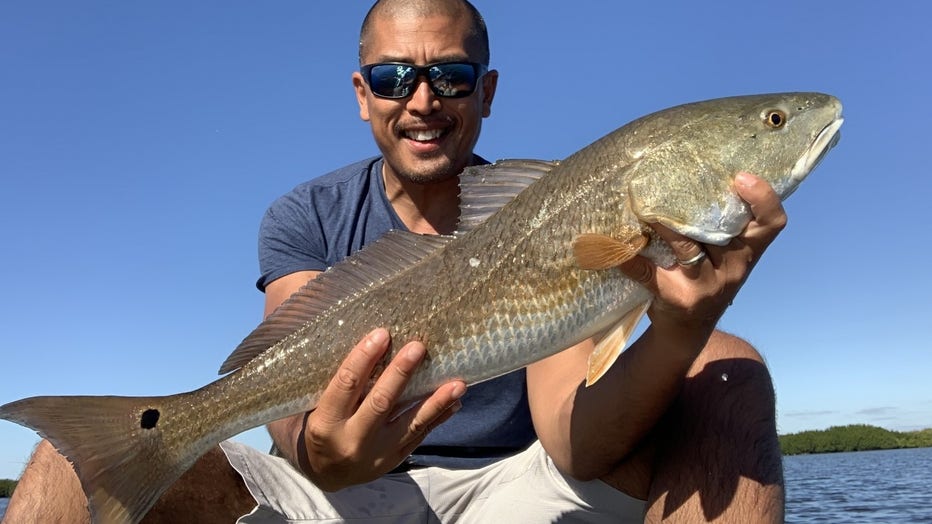
Redfish (Credit: Hubbard's Marina)
Snook action has been pretty good around the passes lately, but most of the numbers are in the back bay feeding actively around the flats, dock lines, and inlets. Anywhere where a snook can sit while bait is funneled to them is a good place to look for them.
They are opportunistic feeders that like to work smart not hard. Right now, lighter tackle and a natural presentation has been important with smaller baits to match the smaller live baits they have been feeding on.
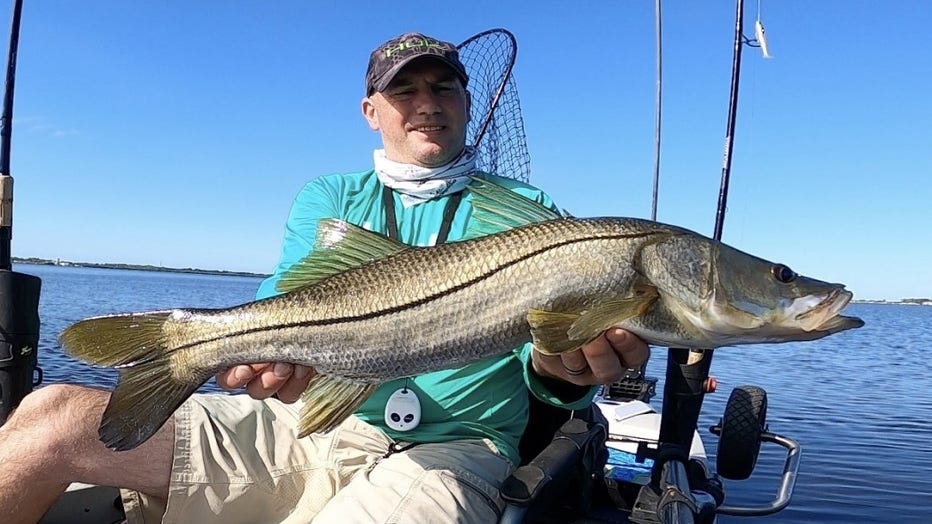
Snook (Credit: Hubbard's Marina)
Trout action has been decent around the area. A bit slower than the typical December trout bite, but the water has been warm and overall numbers seem to be spread out or lower. Look for the trout around those deeper edges of the flats, potholes, or cuts -- especially if you have a sandy drop-off near a flat. That is a good place that will congregate the trout action.
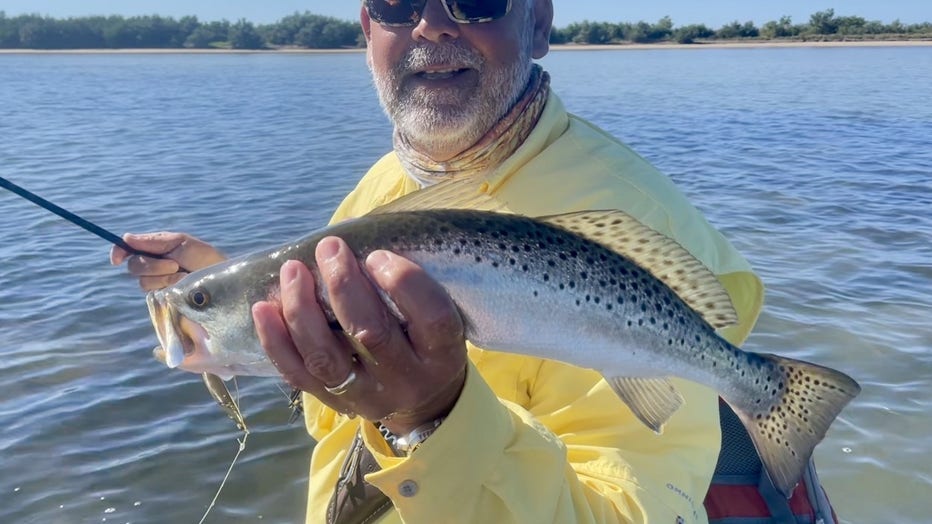
Trout (Credit: Hubbard's Marina)
Sheepshead have been prolific around the area structures lately. We will see that even more prevalent this coming week behind that cold front that will concentrate them even more around the structures of virtually anywhere you go.
Dock lines, seawalls, bridges, piers, rock piles -- pretty much anything that will hold growth -- will have some sheepshead around. However, they can be tricky to get chewing, especially in shallow water. You have to use lighter tackle, smaller hooks, and minimal weights.
Mackerel have been around, especially early morning around local fishing piers, jetties and passes. You can find them along the beaches occasionally too. Plus, local bridges where bait is concentrated the mackerel will not be far behind.
Whiting and silver trout have been steady along the beaches and around our fishing piers -- sometimes even in the passes and sandy areas of Tampa Bay. Pompano jigs along the bottom, live shrimp or slow-moving soft plastics are a great way to target them this time of year.
Pompano have been around some areas lately, but you really must work to find them and have the proper technique to get them to eat. Pompano jigs around those sandy cuts, passes, and sandbars of channels are good areas to look. Sometimes you can find them around the flats, especially when you have some good sandy patches to the flat or sandy areas adjacent. They are hunting the bottom for crustaceans like shrimp or sand fleas.
Flounder action has also been steady around the area. Many of these guys head out of our passes to spawn near shore when the water cools off adjacent to near shore rock piles, reefs, and big structures in 30 to 60 feet of water. However, you can find them around the passes, bridges, and dock lines and even around those sandy patches of the flats as they work to the passes to head near shore.
Near shore
Gag grouper are closing on New Year’s Eve, unfortunately, but we had a great run with a stellar bite in November and December near shore and even around Tampa Bay.
Now, with gags closing, our near shore grouper focus shifts to red grouper which we know are ready to eat around 70 to 100 feet of water. Drifting areas of hard bottom out in that depth on nice weather days -- like we expect this coming Tuesday through Friday -- will produce a great opportunity for some fat keeper red grouper, plentiful lane snapper, vermillions, porgies, and potentially some mangroves and hogfish.
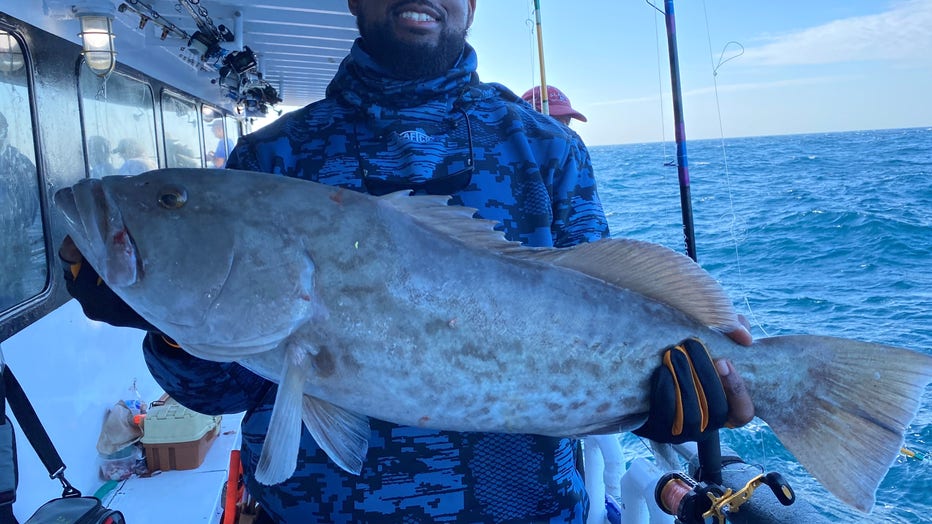
Gag grouper (Credit: Hubbard's Marina)
Anchoring up gives you a better shot at targeting hogfish and mangrove snapper. However, these red groupers are scavengers that spread out over areas of hard bottom looking for a variety of things to eat. Like flats fishing, you don’t want to anchor up on a flat and only fish one small section. Typically, you drift it or put that trolling motor down and cruise the whole flat working all parts of it. This is our approach near shore for red grouper, setting up a drift to work all parts of these larger areas of hardbottom.
This gives us the chance to show our baits to more red grouper and increase the chances of hooking up to some nice keeper-sized fish. Squid strips cut to mimic octopus tentacles, threadfins with the tail cut, butterflied squirrelfish, live lizard fish, and of course, some live pinfish are all great options for these red grouper.
Using around 40-60lb leader and about a 6ot hook is a great option to target them as well tackle wise.
Hogfish action is still hot near shore. It’s been a little slower the past week or so, overall, but we will get back into them as they continue to bite well through the spring in our area. We are seeing them most often around 40 to 70 feet of water while targeting those smaller ledges, rock piles and cuts along the hard bottom areas.
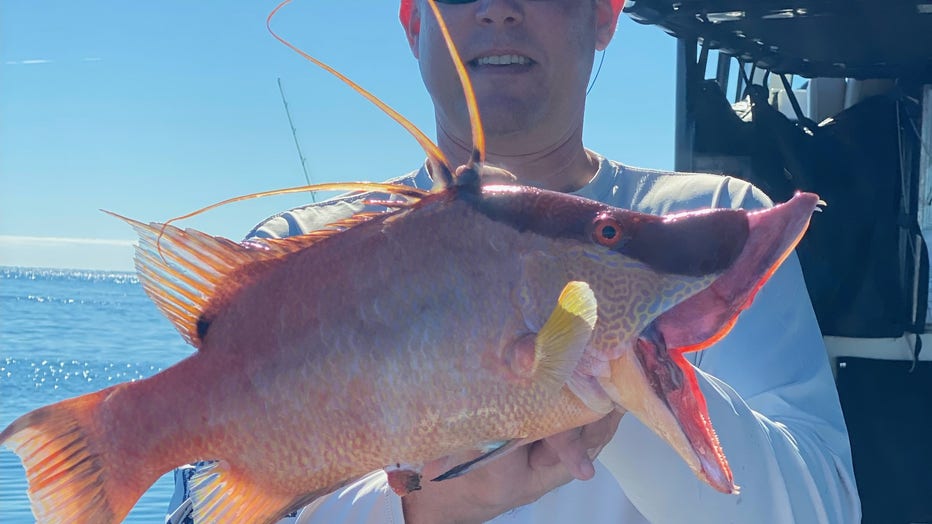
Hogfish (Credit: Hubbard's Marina)
Using live shrimp with lighter 30lb floro is a good way to get them to eat. You can use even 20lb floro but then it makes it trickier to land anything larger that may bite your live shrimp. Around 3-4ot hooks are good options for targeting those hogfish as they have large mouths.
Mangrove snapper are around near shore, but we are seeing most of them in the deeper part of the near shore waters right now closer to that 70 to 100 feet area. They are a bit more hit or miss and we have seen them biting best on live shrimp and cut threadfin.
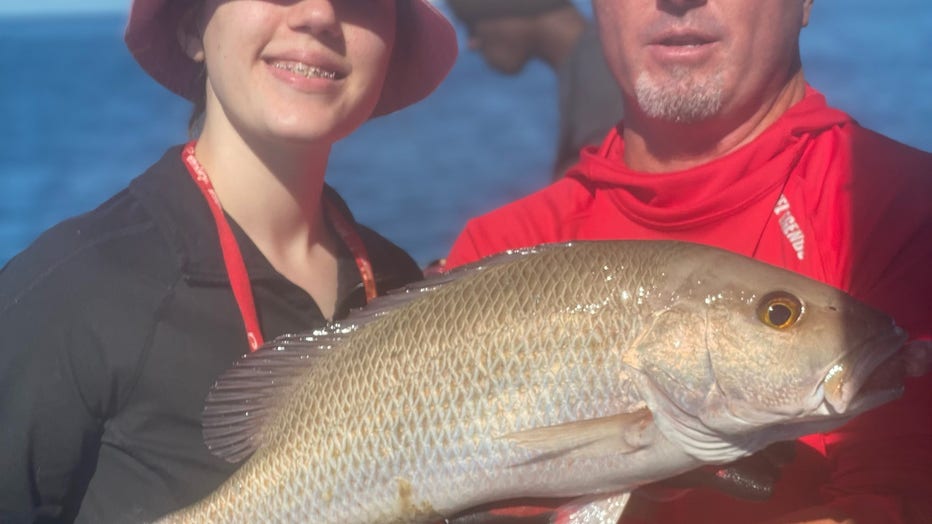
The deeper you go the more prolific and concentrated the mangroves become.
There are still some mackerel around near shore and some kingfish too, but they are pretty spread out. Most of the action we have seen is around the shipping channel and those shipping channel markers. However, sometimes the crab trap lines will hold some bait and thus some mackerel and perhaps a kingfish.
Offshore
Gag grouper ending offshore is sad, but we are super pumped to move deeper and target those fat red grouper around 150 to 250 feet of water with some monster scamp grouper, big vermillions, plentiful mangroves, big porgies, and more stacked up with them. Plus, we have seen some pelagic action too!
It’s a great time to get offshore around mid-to-late week this coming week with a stellar weather window between the fronts. Timing your trips around the weather becomes so important this time of year and the fishing is typically extremely hot during those narrow windows of good weather between disturbances.
Scamp grouper action is going well around that 200-foot mark, and you can get them deeper and a bit shallower too. Smaller to average-sized pinfish, vertical jigs on or near the bottom or sometimes even some smaller squid strips are great ways to target the scamp. Plus, you can often catch them while targeting mangroves on cut threadfin on the double snell rig.
Red groupers love those deep-water potholes. We love to target them with bigger squid strips, butterflied white grunts or squirrel fish, or live pinfish. Sometimes a double threadfin is a great way to get a red grouper to eat as well.
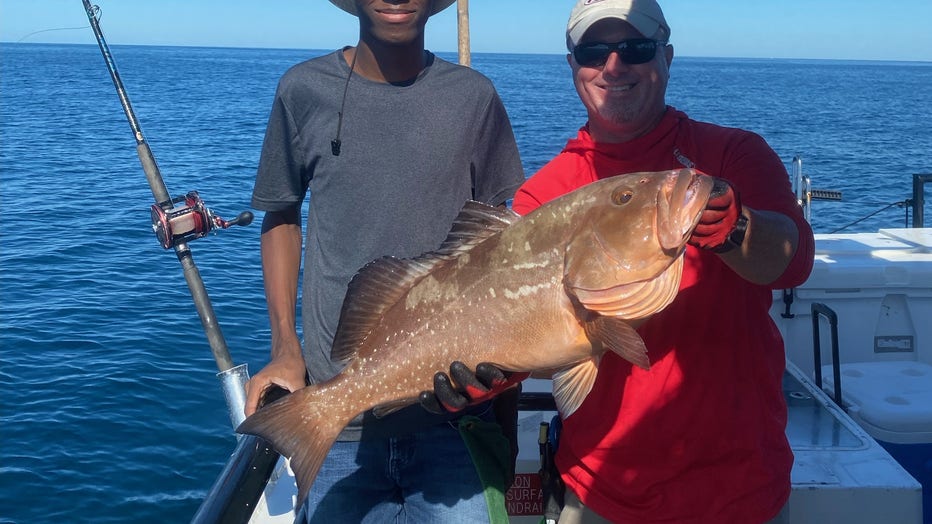
Red grouper (Credit: Hubbard's Marina)
Mangrove snapper fishing is typically pretty darn good around this time of year as gags close, we drop down in leader size considerably and use that 30-40lb even in deeper water with double snelled 5ot hooks and smaller chunks of cut threadfin to really target those smart leader shy bigger mangroves.
Often, our biggest mangrove snapper of the year will come January – March while we have time to really target them in deeper waters offshore.
Blackfin tuna, mahi and some kingfish were all pelagic actors this past week for us offshore. However, some nice wahoo have been caught around the area as well. It’s a great time to get offshore and do some pelagic hunting this time of year -- especially for blackfin tuna!
Don't be a fool; bring a venting tool and/or a descending device
It is so important to keep in mind the importance of dead discards and discard mortality when engaged in near shore or offshore fishing. If we can all work together to change the cultural norms near shore and offshore, we can all help to improve our fishery and our fishery access over time.
How many do you know right now that are all for catching and releasing snook, redfish, and trout but will be the first in line to kill a mangrove snapper, gag grouper or red snapper and the attitude completely changes when discussing these offshore species?
Plus, the same person inshore that will hold their breath and wet their hands before handling a breeder snook will go offshore and then cull through 20 red snappers before keeper their two red snapper they deem large enough to fill their two-fish bag limits while the other 18 they released will often end up suffering fatal damage if not properly descended or vented?
Please help us to spread the word on the importance of descending or venting your released fish. Descending devices are most easy to use and quick to pick up on their use and are most effective for most anglers. However, an expert and precise angler with proper training and tons of experience can use a venting tool properly with similar outcomes. However, a venting tool requires you to pierce the fish while most descending devices are much less invasive.
While using a venting tool it is imperative you pierce them in the exact right spot, and you do not go but a quarter-inch or less in the fish. Most venting tools require you to ‘choke up’ on the tool to prevent over-penetration into major organs.
When fishing deep water, especially in the sweltering summer months, please make sure to treat all fish intended to be released like that breeder snook inshore and minimize the time it takes you to get him from the bottom to the boat using heavier proper tackle not an ultra-light spinning reel. Then once onboard, minimize the time out of the water. Then use a proper dehooking tool, and then for the love of God, use a descending device or venting tool PROPERLY to ensure that fish has a chance to live another day.
Three things will help ensure the survivability of those fish released offshore.
- Making sure they are brought up quickly and do not expend all their energy in the fight.
- Make sure they are unhooked smoothly, easily, and as quickly as possible.
- Finally, make sure they spend the least amount of time at the surface at negative pressures where barotrauma exponentially increases its effect with each passing second.
Also, keep in mind when the water is warm there is less dissolved oxygen content, and the chances of barotrauma increase even more while its effects can be even more deadly.
CHECK OUT THE NEW WEBSITE and marketing campaign to get your own FREE descending device and more information on mitigating barotrauma and barotrauma issues! Do not forget to use the hashtag #ReturnEmRight to help spread the word too on fish you catch and release offshore -> https://returnemright.org/
State survey to improve recreational data and access
It is imperative that you have your gulf reef fish survey endorsement on your fishing license if you are a private recreational angler or diver fishing from a private boat anywhere in Florida who intends to harvest, attempt to harvest or possess one or more of the following reef fish species: mutton snapper, yellowtail snapper, hogfish, red snapper, vermilion snapper, gag grouper, red grouper, black grouper, greater amberjack, lesser amberjack, banded rudderfish, almaco jack, gray triggerfish, Gag grouper, Red grouper, Scamp grouper, Mangrove snapper, Lane snapper, Kingfish, Tuna, or Mahi mahi.
Here is all the information and more on that program and how you can sign up -> https://myfwc.com/fishing/saltwater/recreational/state-reef-fish-survey/
TERMS OF REFERENCE:
INSHORE – from the back bays out to the bridges and including right on the beaches
NEAR SHORE – From the beaches out to 20 miles, or up to 100ft of water
OFFSHORE – from 20 miles or 100ft and beyond
For more fishing reports, photos, videos and more check out Hubbard’s Marina on Facebook, Instagram, YouTube, or Snapchat. Just simply search "HubbardsMarina" and do not forget our family motto, "If you’re too busy to go fishing, you’re just too busy!

